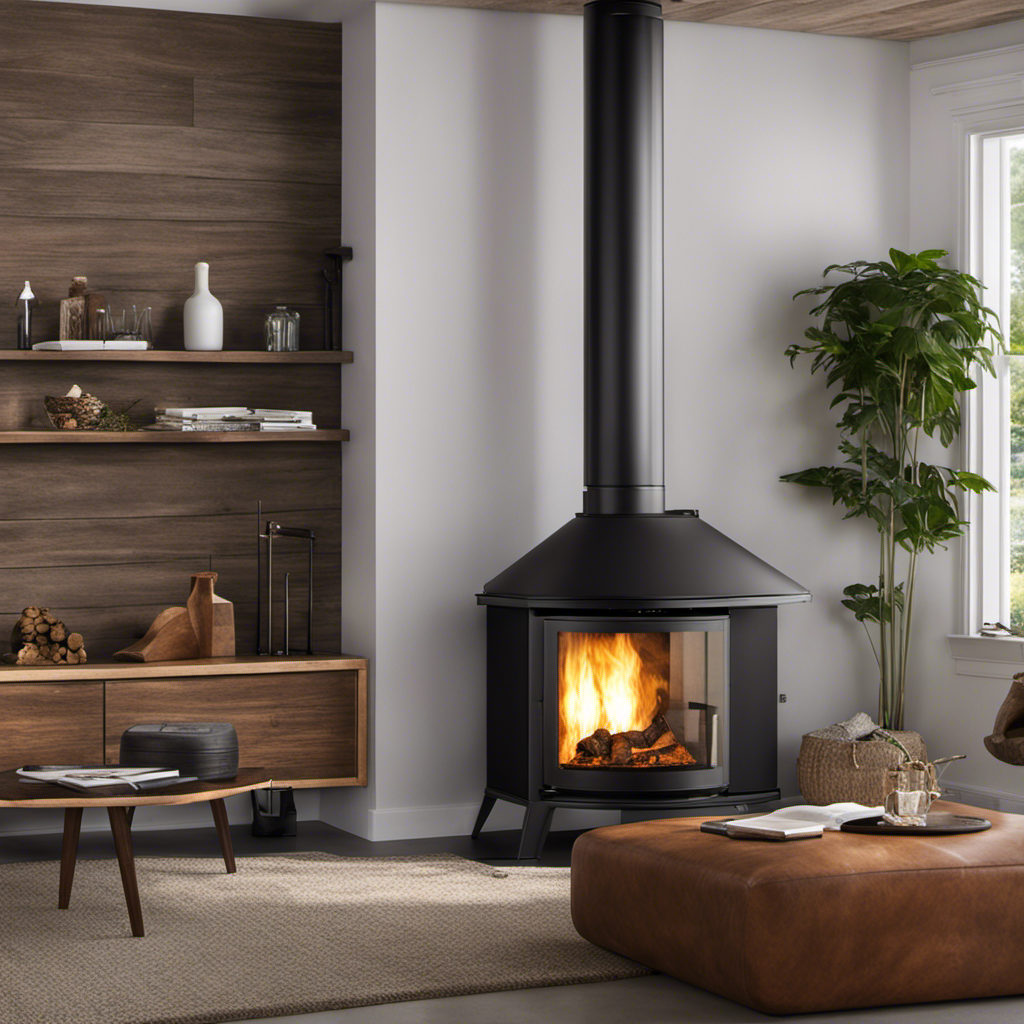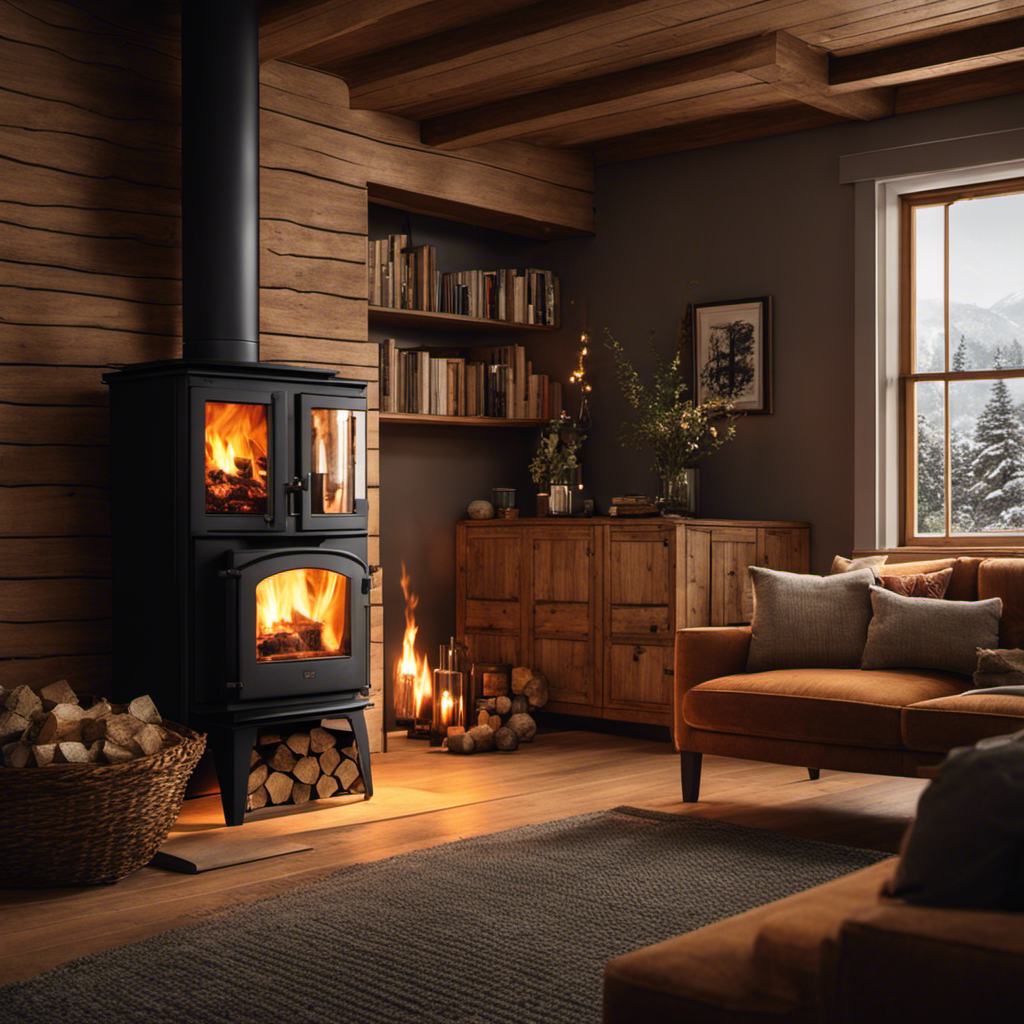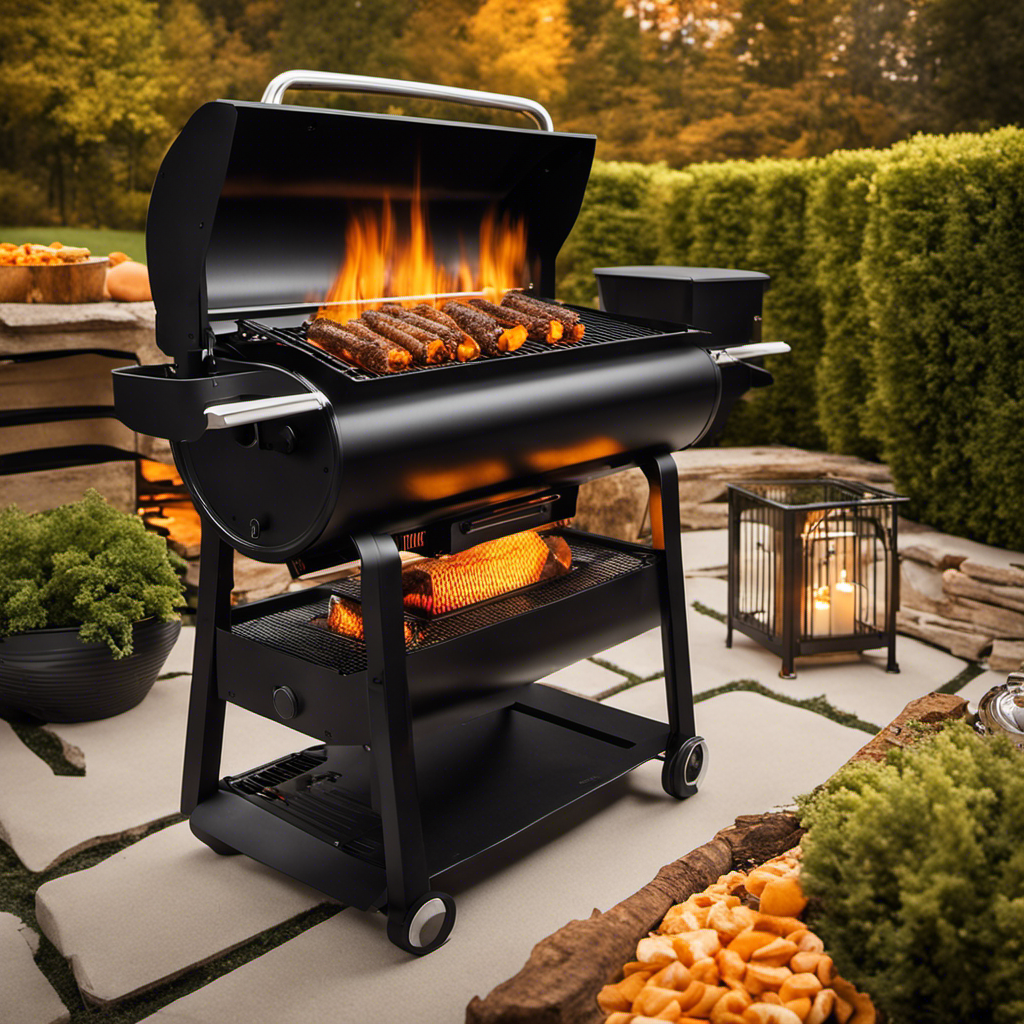My love for barbecue has always been profound, yet it was uncovering the incredible capabilities of a wood pellet grill that completely transformed my adventure in cooking.
What exactly is a wood pellet grill, you ask? Well, get ready to be amazed. These innovative grills combine the convenience of gas grills with the rich flavor of cooking over real hardwood.
In this article, we’ll delve into the history, workings, benefits, and even some mouthwatering recipes for wood pellet grills. Trust me, you won’t want to miss it!
Key Takeaways
- Wood pellet grills were invented by Joe Traeger in the 1980s and revolutionized outdoor cooking with precise temperature control.
- Wood pellets are made from compressed sawdust and wood waste, offering efficient burn and reduced waste.
- Wood pellet grills offer enhanced flavors through the use of wood pellet fuel and versatile cooking techniques like smoking and roasting.
- When choosing a wood pellet grill, consider factors such as brand, size, temperature range, and additional features to find the best fit for your needs.
The History of Wood Pellet Grills
So, you’re probably wondering about the history of wood pellet grills. Well, let me take you on a journey through time and explore the evolution of outdoor cooking.
The history of grilling techniques dates back to ancient civilizations, where our ancestors discovered fire and began using it for cooking food. Over the centuries, various methods were developed, including open fire pits, spit-roasting, and charcoal grills.
However, it was not until the 1980s that Joe Traeger revolutionized outdoor cooking with his invention of the first wood pellet grill. This innovative design allowed for precise temperature control and even heat distribution by using compressed wood pellets as fuel. And so began a new era in barbecue technology.
Now that we understand the historical context, let’s delve into how wood pellet grills work…
How Wood Pellet Grills Work
The pellet combustion process and temperature control mechanism are crucial aspects of how wood pellet grills work. When pellets are fed into the grill’s firepot, they ignite and burn, creating heat and smoke for cooking.
This combustion process is carefully regulated by a controller that adjusts the air intake and fuel supply to maintain a consistent temperature inside the grill.
Understanding these key points is essential for mastering the art of wood pellet grilling and achieving delicious, perfectly cooked meals every time.
Pellet Combustion Process
During the pellet combustion process, wood pellets are burned to create heat and smoke. Wood pellet grills use a specific type of fuel called pellets, which are made from compressed sawdust and other wood waste materials.
Pellet fuel production involves grinding the raw materials into a fine powder and then compressing it under high pressure to form small cylindrical pellets. This process helps in reducing waste and utilizing leftover wood scraps that would otherwise be discarded. Not only does this make pellet grilling an environmentally friendly option, but it also ensures a consistent and efficient burn.
The controlled combustion of these pellets produces both heat for cooking and smoke for flavoring the food.
Now, let’s dive into how the temperature control mechanism works in wood pellet grills without any delay.
Temperature Control Mechanism
Using a temperature control mechanism, wood pellet grills allow users to easily adjust the heat for precise cooking. This makes it possible to achieve perfect doneness every time. Here are some temperature control techniques that can be utilized with a wood pellet grill:
- Set the desired temperature using the digital control panel.
- Monitor the internal temperature of your food by using a built-in thermometer.
- Adjust the airflow and damper settings to control the intensity of the heat.
- Use an app-connected feature to remotely monitor and adjust the temperature from your phone.
- Utilize programmable cooking modes for specific recipes or cooking styles.
With these temperature control techniques, you can have full control over how your food is cooked, ensuring that it reaches its ideal level of doneness.
Now let’s explore the benefits of using a wood pellet grill, which go beyond just precise temperature control.
The Benefits of Using a Wood Pellet Grill
You’ll love the benefits of a wood pellet grill. Not only does it offer convenience and ease of use, but it also enhances the flavors of your food and allows for versatile grilling techniques. With a wood pellet grill, you can achieve that smoky, charred taste that is often associated with traditional charcoal grills, while still enjoying the convenience of gas grills. The secret lies in the wood pellets that are used as fuel. These pellets come in various flavors such as mesquite, hickory, applewood, and more, allowing you to experiment and add different layers of flavor to your dishes. The table below summarizes some key benefits of using a wood pellet grill:
| Benefits | Description |
|---|---|
| Enhanced Flavors | Wood pellets infuse your food with delicious smoky flavors |
| Versatile | Allows for various cooking techniques like smoking and roasting |
| Convenient | Easy temperature control and automated features simplify grilling |
| Efficient | Wood pellets burn efficiently, resulting in less waste |
| Consistent | Precise temperature control ensures even cooking every time |
With all these benefits in mind, let’s now explore the different types of wood pellet grills available on the market today…
Different Types of Wood Pellet Grills
There are several different types of wood pellet grills available on the market today, each offering its own unique features and advantages. When it comes to choosing the right wood pellet grill, it’s important to consider factors such as size, temperature range, and additional features.
Some popular brands of wood pellet grills include Traeger, Pit Boss, and Green Mountain Grills. Traeger is known for their wide range of models and reliable performance. Pit Boss offers a more affordable option without compromising on quality or functionality. Green Mountain Grills are praised for their advanced technology and precision temperature control.
While all wood pellet grills offer the convenience of easy temperature adjustment and versatility in cooking options, it’s important to weigh the pros and cons before making a decision.
Now that you have an idea about different brands of wood pellet grills and their pros and cons, let’s move on to choosing the right wood pellets for your grill…
Choosing the Right Wood Pellets for Your Grill
To ensure optimal flavor and performance, it’s essential to select the right type of wood pellets for grilling. Choosing the best fuel for your grill can greatly enhance your overall grilling experience. Here are some tips to help you choose the perfect wood pellets:
-
Consider the smoke flavor profiles:
-
Fruitwood: Imparts a sweet and mild flavor, perfect for poultry and fish.
-
Hardwood: Provides a strong smoky taste, ideal for beef and pork.
-
Understand the different types of wood pellets available:
-
Hickory: Known for its bold and robust flavor, great for all types of meats.
-
Apple: Offers a slightly sweet and fruity aroma, pairs well with pork.
By understanding these smoke flavor profiles, you can tailor your choice of wood pellets to complement different types of meat.
Now that you know how to choose the right wood pellets, let’s move on to some tips and tricks for grilling on a wood pellet grill.
Tips and Tricks for Grilling on a Wood Pellet Grill
When it comes to grilling on a wood pellet grill, two key factors that can greatly enhance your cooking experience are temperature control techniques and the ability to infuse smoky flavors into your food.
Mastering temperature control is essential for achieving perfectly cooked meats and vegetables every time. From using the grill’s built-in temperature settings to adjusting the ventilation, understanding these techniques will allow you to have full control over the cooking process.
Additionally, by experimenting with different types of wood pellets and utilizing smoke boxes or trays, you can easily add an extra layer of delicious smokiness to your dishes for a truly mouthwatering experience.
Temperature Control Techniques
Achieving precise temperature control on a wood pellet grill is essential, so you’ll need to familiarize yourself with the various techniques available. One of the most common methods is adjusting the airflow. By opening or closing the vents, you can regulate the amount of oxygen that reaches the fire, thus controlling the heat.
Another technique involves using a digital thermometer to monitor and adjust the temperature accurately. This allows for more precise cooking and ensures your food turns out perfectly every time.
The benefits of using a wood pellet grill for temperature control are numerous. It provides consistent heat distribution throughout the cooking process, resulting in even cooking and delicious flavors. Additionally, these grills offer a wide range of temperature settings, allowing you to cook anything from low and slow smoked meats to high-temperature searing.
With proper temperature control techniques, you can elevate your grilling game and achieve mouthwatering results.
When it comes to enhancing smoky flavors on a wood pellet grill…
Enhancing Smoky Flavors
If you want to enhance the smoky flavors of your food, try experimenting with different types of wood chips. Smoke infusion techniques are a great way to add depth and complexity to your dishes.
Here are three tips for enhancing smoky flavors using wood chips:
-
Choose the right type of wood chips: Different woods impart different flavors, so it’s important to select the right one for your desired flavor profile. For example, mesquite wood chips provide a strong, bold flavor, while fruitwoods like apple or cherry offer a sweeter and more delicate smoke.
-
Soak the wood chips: Before adding them to your grill or smoker, soak the wood chips in water for about 30 minutes. This helps prevent them from burning too quickly and creates more smoke for better flavor infusion.
-
Use a smoking box or foil packet: To control the release of smoke and prevent flare-ups, place the soaked wood chips in a smoking box or create a foil packet with small holes poked into it. This allows the smoke to slowly infuse into your food without causing excessive charring.
By following these tips, you can elevate the smoky flavors of your grilled or smoked dishes to new heights.
When it comes to maintaining and cleaning your wood pellet grill, proper care is essential for optimal performance and longevity without compromising on flavor profiles.
Maintenance and Cleaning of Wood Pellet Grills
Regularly cleaning and maintaining your wood pellet grill will ensure optimal performance and longevity. To keep your grill in top shape, here are some maintenance tips to follow.
First, always make sure to clean the cooking grates after each use. Use a wire brush to remove any leftover food particles or grease buildup.
Next, check the ash trap regularly and empty it as needed to prevent clogs and maintain proper airflow.
Additionally, don’t forget to clean the drip tray and grease bucket to avoid flare-ups and maintain a safe cooking environment.
Finally, inspect the grill for any signs of wear or damage and address them promptly.
Now that we’ve covered the importance of maintenance, let’s delve into exploring unique recipes for wood pellet grills without skipping a beat!
Exploring Unique Recipes for Wood Pellet Grills
Let’s start by discovering some delicious and creative recipes that you can try on your wood pellet grill. Cooking on a wood pellet grill opens up a world of unique recipe ideas and allows for exciting cooking techniques. Whether you’re a seasoned griller or just starting out, these recipes will surely impress your friends and family.
Check out the table below for some mouthwatering recipe suggestions:
| Recipe | Description | Ingredients |
|---|---|---|
| Smoked Brisket | Tender and flavorful slow-cooked beef | Brisket, rub seasoning, wood pellets |
| Grilled Pineapple Skewers | Sweet and tangy tropical treat | Fresh pineapple chunks, honey, lime juice |
| Cedar Plank Salmon | Smoky salmon with a hint of cedar flavor | Salmon fillets, cedar planks, lemon slices |
| Bacon-Wrapped Jalapeno Poppers | Spicy appetizers wrapped in crispy bacon | Jalapenos, cream cheese, bacon strips |
These recipes are just the tip of the iceberg when it comes to exploring the possibilities of cooking on a wood pellet grill. Get creative with flavors and experiment with different ingredients to create your own unique dishes. Happy grilling!
Frequently Asked Questions
How Much Do Wood Pellet Grills Typically Cost?
Wood pellet grills typically cost between $300 to $2,000, depending on the brand and features. They offer a unique cooking experience by using wood pellets as fuel, providing a smoky flavor to your food.
Are Wood Pellet Grills Suitable for Beginners?
Yes, they are suitable for beginners. Wood pellet grills offer easy maintenance and a range of benefits, like consistent temperature control and enhanced flavor. I highly recommend them to anyone starting out in grilling.
Can You Use Wood Pellet Grills for Smoking Food?
Yes, you can use wood pellet grills for smoking food. They are versatile and offer a variety of wood pellet grill recipes. The benefits of smoking food with wood pellets include enhanced flavor and even cooking.
Are Wood Pellet Grills Environmentally Friendly?
Wood pellet grills are environmentally friendly. While some may argue that their production impact is high, when compared to traditional grills, wood pellet grills have a significantly lower environmental impact in terms of emissions and fuel usage.
Can You Use Wood Pellets Other Than Hardwood in a Wood Pellet Grill?
Yes, you can use alternative wood pellets in a wood pellet grill. Using different types of wood pellets can enhance the flavor profile of your food, offering a variety of smoky and aromatic benefits.
Conclusion
After exploring the world of wood pellet grills, I must say, they are an absolute game-changer! These incredible machines take grilling to a whole new level.
The convenience and versatility they offer are unmatched. From perfectly seared steaks to deliciously smoked ribs, there’s nothing you can’t cook on a wood pellet grill. And let’s not forget the mouthwatering flavors imparted by the wood pellets.
Trust me, once you experience the magic of a wood pellet grill, you’ll never want to go back to traditional grilling methods again!











